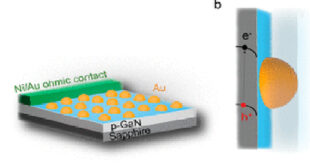Significance
High-efficiency photon sieves designed for terahertz frequencies represent a cutting-edge advancement in the field of optics and photonics. A photon sieve is a type of diffractive optical element. It typically consists of a flat surface punctured with a large number of tiny holes or slits arranged in a specific pattern. In high-efficiency photon sieves for terahertz frequencies, these patterns are specifically designed to manipulate light (or electromagnetic waves) in the terahertz range of the spectrum (0.1 to 10 THz). Terahertz frequencies sit between microwave and infrared on the electromagnetic spectrum and have unique properties. Materials transparent to visible light can be opaque in the terahertz range, and vice versa. The design of these sieves often involves sophisticated algorithms and can be based on principles like Fresnel zones or other diffractive optics techniques. The applications for high-efficiency photon sieves are enormous including Imaging and Security where terahertz radiation can penetrate materials like clothing and packaging, making photon sieves useful in non-invasive security scanning and imaging systems. Additionally, it is used in spectroscopy and material Analysis where terahertz waves interact uniquely with different materials, enabling detailed spectroscopic analysis for chemical identification, quality control in manufacturing, and pharmaceuticals testing. Moreover, the terahertz band is seen as a frontier for next-generation wireless communication technologies, potentially offering higher data transmission rates. Photon sieves can play a role in signal processing and manipulation in these applications. Furthermore, terahertz imaging, aided by high-efficiency photon sieves, can offer non-invasive medical diagnostics, potentially providing safer alternatives to X-rays for some applications. The development and refinement of these photon sieves continue to be an area of active research, driven by the potential for breakthroughs in these and other fields.
In a new study published in the peer-reviewed Journal Applied Optics led by Professor Qing Cao and conducted by Changjie Cheng, Lihua Bai, Chaoyue Li, Jirui Zhu, Wenxuan Chen, and Yaxing Mao from the Department of Physics, Shanghai University investigated the enhancement of photon sieves – a component critical in focusing electromagnetic waves. Traditional photon sieves encountered limitations, primarily due to low diffraction efficiency and dispersion issues arising from multiple waveguide modes in the pinholes. Addressing these challenges, the researchers introduced a novel design for a photon sieve operating within the THz band, which uses metal square-hole waveguides. The core innovation lies in manipulating the effective indices of these pinholes, thereby adjusting the optical path differences. This approach significantly ameliorates the focusing ability of the sieve, as demonstrated through comprehensive simulations.
The authors introduced a novel photon sieve design that incorporates metal square-hole waveguides. Unlike traditional circular pinholes, these square holes offer a unique way to manipulate the effective refractive index within the waveguide. A critical aspect of their design was the ability to adjust optical path differences by varying the side lengths of the square holes. This fine-tuning allows for more precise control over the waveguide effect, crucial for enhancing the focusing capabilities of the sieve. The team engineered a multilevel distribution of optical paths within a fixed thickness of the photon sieve. Each level corresponded to different pinhole sizes, enabling optimal management of optical paths to ensure constructive interference at the focus point. To validate their theoretical model, extensive simulations were conducted. These simulations demonstrated a significant increase in intensity at the focus point when compared to traditional photon sieve designs.
The researchers embarked on a methodical journey, starting with identifying the drawbacks of existing photon sieves. Acknowledging the low diffraction efficiency and the waveguide mode dispersion as key impediments, they proposed a conceptually novel design. The new design pivots around metal square-hole waveguides, where the effective index is influenced by the pinhole’s side length. By adjusting these parameters, the researchers could fine-tune the optical path differences, leveraging the waveguide effect to enhance focusing. In practical terms, this involved establishing a multilevel distribution of optical paths within a fixed thickness of the photon sieve, each corresponding to a different pinhole size. This intricate configuration allowed for the optimal management of optical paths, ensuring that all pinholes contributed constructively to the focus. The team then validated their theoretical model through simulations, demonstrating a significant increase in intensity compared to traditional designs.
The importance of the new study is it advances the THz Wave Focusing. The THz frequency band is essential for various applications, including imaging and spectroscopy. The enhanced photon sieve significantly improves the focusing of THz waves, which can lead to advancements in these areas. Moreover, the findings have profound implications for the broader field of optical engineering. The ability to precisely control and manipulate light with such efficiency opens up new possibilities in diffractive optics. Improved THz wave focusing could benefit as well telecommunications, medical imaging, security scanning, and potentially astronomical observations.
In summary, by Professor Qing Cao and team work in developing high-efficiency square-hole single-mode waveguide photon sieves represent a significant advancement in the control and manipulation of THz waves. Their innovative approach in tackling the limitations of traditional photon sieves has not only enhanced the efficiency of these devices but also opened up new possibilities for their application in various scientific and technological domains.
Reference
Cheng C, Cao Q, Bai L, Li C, Zhu J, Chen W, Mao Y. High-efficiency square-hole single-mode waveguide photon sieves for THz waves. Appl Opt. 2023;62(10):2403-2409. doi: 10.1364/AO.482840.
 Advances in Engineering Advances in Engineering features breaking research judged by Advances in Engineering advisory team to be of key importance in the Engineering field. Papers are selected from over 10,000 published each week from most peer reviewed journals.
Advances in Engineering Advances in Engineering features breaking research judged by Advances in Engineering advisory team to be of key importance in the Engineering field. Papers are selected from over 10,000 published each week from most peer reviewed journals.





